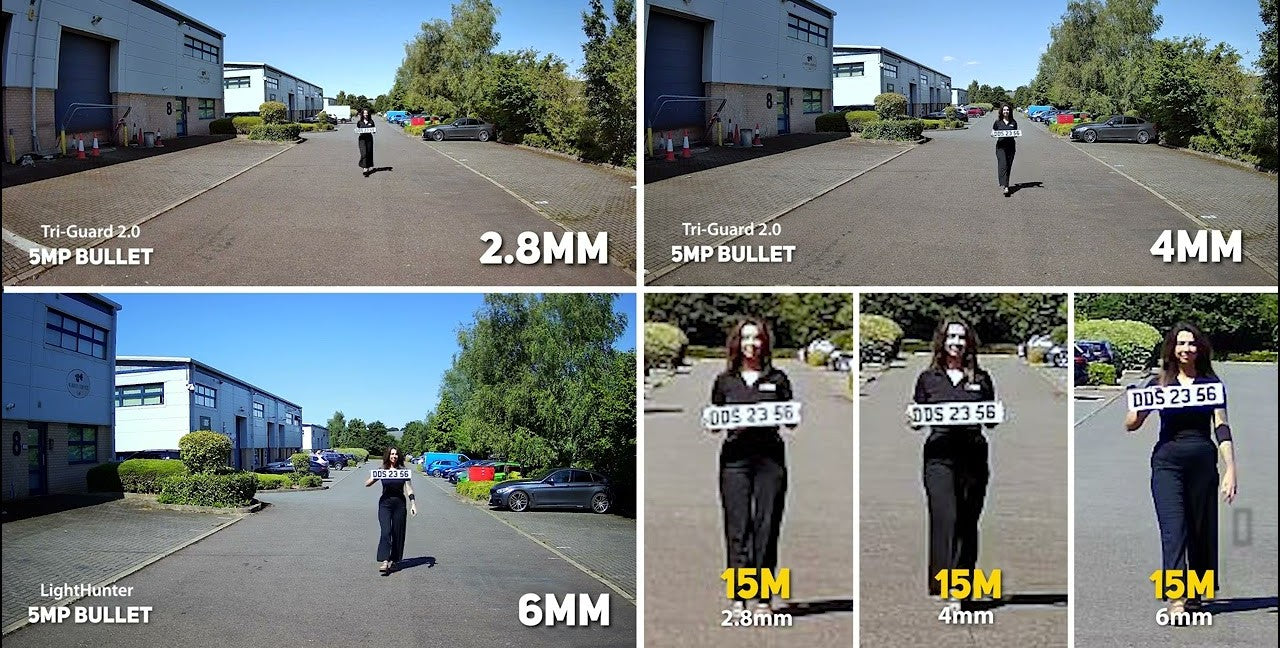When investing in a CCTV system, most buyers focus on brand, resolution, or night vision features. But there’s one small spec that makes a big difference: the lens size. Two of the most popular options are the 2.8mm and 4mm lenses — both widely used in residential and commercial surveillance.
So, what’s the real difference between a 2.8mm lens and a 4mm lens in CCTV cameras? Which one is better for you? And where should you buy it in Australia?
Let’s break it all down
1. The Basics: What Does Lens Size Mean in CCTV?
The lens size in millimeters affects how much area the camera can see (field of view) and how close it appears (zoom level). The lower the number, the wider the view — but objects will appear smaller. A higher number means a narrower view, but you’ll get more detail in distant objects.
Here’s a quick comparison:
| Lens Size | Field of View (FOV) | Best For | Trade-Off |
|---|---|---|---|
| 2.8mm | 90° – 120° (wide) | Wide area coverage | Less detail on distant objects |
| 4mm | 60° – 90° (narrower) | Focused areas, entry points | Less area coverage, more detail |
2. 2.8mm Lens: When You Need to See More
The 2.8mm lens is ideal when you want to monitor a large area with a single camera. It gives you that fish-eye-like effect that captures more in the frame — perfect for surveillance where detail isn’t as critical, but coverage is.
🔍 Where to Use a 2.8mm Lens:
- Retail Stores: Monitor aisles, open-floor layouts, or customer traffic.
- Home Front Yards: Cover a wide angle of the property with a single cam.
- Warehouses: Oversee large storage areas or production lines.
- Office Lobbies: Watch entrances and large waiting areas.
- Reception Desks: Track visitors walking into a facility.
👤 Who Should Buy:
- Homeowners looking for full-yard visibility.
- Business owners who want general surveillance.
- Installers setting up systems in open-plan areas.
✅ Pros:
- Excellent coverage with fewer cameras.
- Great for general observation.
- Ideal for DIY setups.
❌ Cons:
- Limited facial recognition at a distance.
- Not ideal for long-distance identification.
3. 4mm Lens: When Clarity and Focus Matter
The 4mm lens narrows the viewing angle but increases clarity — perfect when your priority is detail, not breadth. This makes it the go-to option when you need to identify faces, license plates, or movement in a specific zone.
🔍 Where to Use a 4mm Lens:
- Driveways: See who’s coming and going, clearly.
- Entryways: Focus on doorways or gates for facial recognition.
- Cash Registers: Capture clear footage of transactions.
- Hallways: Narrow field of view is perfect for corridor layouts.
- Loading Docks: Track vehicle activity and package handling.
👤 Who Should Buy:
- Security professionals who need precise footage.
- Businesses monitoring sensitive points.
- Homeowners wanting detailed footage of entrances.
✅ Pros:
- Clearer image for facial recognition.
- Better detail in distant objects.
- Ideal for identifying events in tighter spaces.
❌ Cons:
- Reduced coverage — may need more cameras.
- Blind spots possible if not placed correctly.
4. Which Should You Choose?
Here’s a simple rule of thumb:
- Choose 2.8mm if you want maximum coverage — fewer cameras, broader scenes.
- Choose 4mm if you need clear detail in a specific area — tighter shots, better identification.
Still unsure? Mix and match! Many professional CCTV setups use a combination of lens sizes for optimized surveillance.
5. Why Buy Your CCTV Lenses from CCTVImporters.com.au?
🇦🇺 100% Aussie-Owned and Operated
cctv importers - cctvtradie Support a locally-run business that understands the security needs of Australian homes and businesses.
💰 Wholesale Pricing, Direct to You
Get wholesale rates from cctvtradie with no middleman markup. That means better quality for your dollar, whether you're a DIY home user or a professional installer.
📦 Fast Shipping, Reliable Stock
Based in Australia, CCTVImporters.com.au offers quick dispatch and nationwide shipping — no delays, no drop-shipping hassles.
👨💻 Expert Advice & Support
Not sure if 2.8mm or 4mm is best for your setup? Our cctvtradie tech team is always available for real advice, not pushy sales talk.
✅ Trusted Brands and Warranty Backing
We stock only reliable, tested brands with full warranties. If it's in our cctvtradie store, it’s been vetted.
Final Thoughts
Your security camera is only as good as the lens you choose. While both 2.8mm and 4mm options have their strengths, your location, goals, and priorities determine which one is right for you.
Still deciding? Don't guess — talk to the pros at CCTVImporters.com.au and get expert help choosing the right lens for your setup.
FAQ
1. Can I mix 2.8mm and 4mm lenses in one system?
Yes! Mixing them gives you the best of both worlds — wide coverage and focused clarity.
2. Is 2.8mm or 4mm better for facial recognition?
4mm is better. It offers more detail and is ideal for identifying faces or license plates.
3. Will a 2.8mm lens miss details at night?
Not necessarily, but if you're watching something far away, a 4mm lens may perform better in identifying features.
4. Are these lens options available in dome and bullet cameras?
Yes, both lens sizes are commonly found in a variety of camera types including dome, turret, and bullet.
5. Do I need professional installation?
Not always. 2.8mm cameras are great for DIY installations, while 4mm setups may benefit from a pro for optimal positioning.









